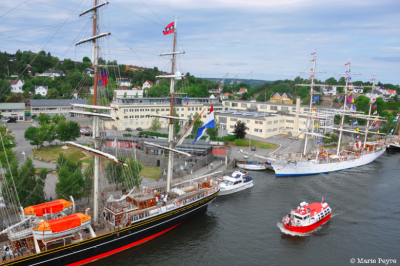One of Norway’s three most famous tall-masted sailing ships, the Christian Radich, faces winter lay-up after the Norwegian Navy (Sjøforsvaret) decided to stop using the vessel for traditional training exercises. The vessel has been used by naval officer candidates to hone their sailing skills, but now the training program is being dropped in an effort to cut costs.

“I realize that this creates challenges for Christian Radich, but we need to focus on our primary assignments,” Thomas Wedervang, chief of the military’s naval training schools, told newspaper Aftenposten on Wednesday. “That involves crewing our ships and being able to be in charge of the fleet. That’s where we need to use our resources.”
The Navy’s use of the Oslo-based Christian Radich has provided the foundation that keeps it sailing with NOK 10 million a year. The funding is needed to help maintain and operate the three-masted vessel, which was built as a training ship in 1937. The threat of losing its military contract surfaced last year, and now the navy has decided that the traditional training has simply become too expensive and unnecessary at a time of tight military budgets.
“This means we’re losing around a third of our revenues,” Einar Corwin, director of the foundation (Stiftelsen Christian Radich), told Aftenposten. The naval officers’ training program also kept the vessel active in the winter months, and Corwin fears that winter lay-up will damage the ship that otherwise is used for ceremonial events, long-distance summer cruising for sailing enthusiasts and occasional sightseeing on the Oslo Fjord. The vessel is also available for private charter, has often been used for parties and receptions within the shipping industry and has won the Tall Ships Races several times. It participated in the recent Tall Ships Races that called at both Fredrikstad and Bergen this past summer.

“At festive events, everyone agrees that we’re carrying on an important cultural tradition that’s both important and valuable,” Corwin said with a sigh. It’s not easy, though, for fans of the vessel to turn such words of support into financial support, even though a state commission decreed in 2002 that Norway should be able to afford to keep the sailing ship in year-round operation with training programs. Many other nations including Sweden, the US, Russia and Spain maintain classic schooners to keep the tradition alive.
“The vessel was built to sail,” Corwin said. He noted that Christian Radich was in winter lay-up from 1998 to 2005, when it also faced financial challenges, and it deteriorated quickly. It’s also difficult to find crews and staff if they can only be offered jobs in the summer months.
The vessel, which celebrated its 75th anniversary in 2012 with Crown Prince Haakon on board, needs around NOK 30 million in funding every year and generates around NOK 10 million of it during the summer months itself. Another NOK 7 million in funding comes from the state Ministry of Culture. “The challenge now is to figure out how we can earn more money and keep the vessel active during the winter, when the agreement we had with the Navy was so important,” Olav Sollie, chairman of the Christian Radich’s foundation, told Aftenposten.
The Christian Radich won international fame when it was used in the Windjammer film and in a TV series in the 1970s. Norway has two other Tall Ships that also face ongoing challenges: Sørlandet, home-ported in Kristiansand, recently ended a three-year contract with a Canadian school and now also is heading into winter lay-up. Bergen’s Statsraad Lehmkuhl still has a contract with the Navy but it’s due to expire in 2017.
newsinenglish.no/Nina Berglund

